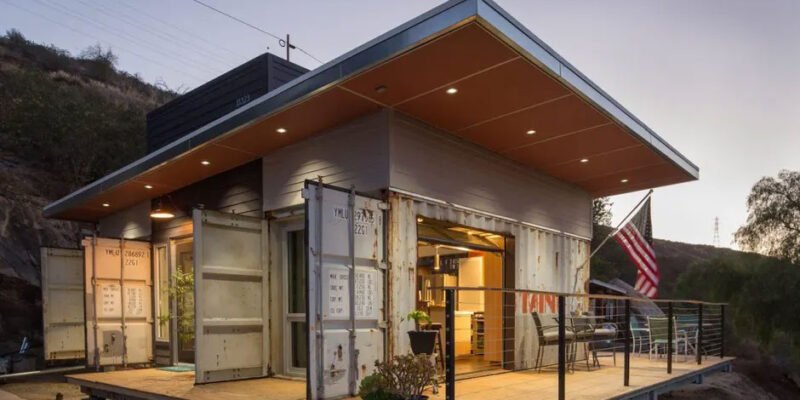Introduction
In the realm of modern architecture, the concept of repurposing shipping containers as versatile living spaces has gained significant momentum. The convergence of sustainability, functionality, and affordability has paved the way for innovative designs that challenge traditional construction norms. In this article, we delve into the captivating realm of shipping container garages – a fusion of creativity and utility that showcases how these industrial giants can be transformed into comfortable and eco-friendly abodes.
Lakeside Container Cottage: A Design Marvel
Designed by the ingenious Christopher Bittner, the Lakeside Container Cottage stands as a testament to the potential of shipping containers. Nestled within the picturesque landscape of San Diego County, this 720 sq. ft. marvel boasts a non-combustible exterior, a critical feature considering its location in a wildfire-prone zone. Dual pane-tempered exterior glass, Class A roofing materials, and fire sprinklers underscore its safety, while cement board siding and soffit panels, along with single-ply thermoplastic polyolefin roofing, complete the robust ensemble.
Crafting Dreams: The McConkey Residence
For homeowners Shawn and Mike McConkey, the dream of a container home became a reality. Combining the expertise of architectural engineer and construction superintendent Mike, along with a skilled general contractor and architect, the McConkey Residence emerged. Having previously erected a container-based farm stand, Mike brought valuable insights to the project. Southern California’s temperate climate facilitated the use of a standard, low-overhead garage door that could remain open for ventilation year-round. The strategic incorporation of glass panels allowed natural light to cascade in, creating an inviting ambiance.
Challenges and Triumphs
However, the journey wasn’t without its challenges. Modifying containers to accommodate windows and doors, while maintaining structural integrity, demanded ingenious solutions. Overcoming construction approval hurdles, given the novelty of the approach, required time and patience. Joining conventional materials with the steel infrastructure of containers posed yet another puzzle. Architect Christopher Bittner emphasizes the importance of selecting capable builders for such projects. Despite the obstacles, the McConkey Residence emerged as a comfortable and visually pleasing testament to container-based construction.
Elevated Sustainability: Sugarloaf Mountain Abode
Venturing to Sugarloaf Mountain above Boulder, another container-based gem awaits – an abode of elevated energy efficiency. Anchored by three shipping containers, this dwelling integrates structural insulated panels (SIPS) to form a central living space. The clever design not only minimizes reliance on external utilities but also capitalizes on recycled and reclaimed materials. A spacious deck extends from the living and dining area, framing panoramic views of Boulder and the Flatirons to the south.
Embracing Energy Independence
Energy efficiency takes center stage in this endeavor. Meticulous selection of appliances, fixtures, and air conditioning systems, coupled with a photovoltaic array atop the detached garage, enables surplus electricity generation. The excess energy is seamlessly fed back into the grid, underscoring the sustainability ethos that defines this architectural innovation.
The Origins of Creativity: Repurposed Shipping Containers
Beyond individual projects, a broader narrative unfolds – that of repurposing discarded shipping containers. The United States’ surplus of used containers, a byproduct of imbalanced import-export dynamics, has given rise to an abundance of potential building blocks. Cost-effective and structurally robust, containers offer stackability, interlockability, and resilience. These qualities, coupled with their ability to withstand extreme conditions, position them as unconventional yet compelling choices for construction.
Overcoming Hurdles
Yet, challenges persist. Converting containers into habitable spaces demands insulating Corten Steel structures, requiring both expertise and investment. Crafting modifications necessitates skillful metalwork, while navigating building permits can prove complex. Despite these intricacies, the allure of transforming industrial relics into living havens continues to captivate architects, builders, and dreamers alike.
Conclusion
The evolution of shipping containers from cargo vessels to architectural wonders epitomizes human ingenuity. From Lakeside Container Cottage’s fire-resistant exterior to the McConkey Residence’s innovative garage door and the sustainable haven atop Sugarloaf Mountain, each project reshapes our perception of space and possibility. As we embrace the imperfections and triumphs of container-based construction, the journey from discarded to desired unfolds, inviting us to reimagine the very essence of modern living.













Comments